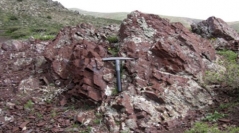

 Comptes Rendus Palevol
14 (2) - Pages 73-84
Comptes Rendus Palevol
14 (2) - Pages 73-84The Yüksekova complex in SE Turkey is a part of a continuous belt of ophiolites and subduction–accretion complexes that stretches from Troodos in the west to Oman in the east, representing the remnants of the Southern Branch of Neotethys. This complex mainly comprises a tectonically chaotic assemblage of basaltic dykes and pillow lavas associated with radiolarian cherts, shales and pelagic limestones. Detailed petrological work on submarine basaltic lavas from Elazig-Malatya area in SE Turkey revealed the presence of two distinct tectonomagmatic groups displaying island arc and back-arc characteristics. Radiolarian assemblages are described for the first time from radiolarian cherts in primary depositional contact with the basaltic rocks in this belt. Two distinct assemblages are recognized as Upper Cenomanian to Lower Turonian and Lower Coniacian to Lower Maastrichtian based on the characteristic radiolarian taxa. The new fossil data supports the suggestions that the southern branch of Neotethys has closed by intra-oceanic subduction where the arc and back-arc type oceanic crust generation was involved not earlier than Upper Cretaceous.
Southern Neotethys, Yüksekova Complex, Pillow basalts, Radiolarians, Upper cretaceous, Turkey